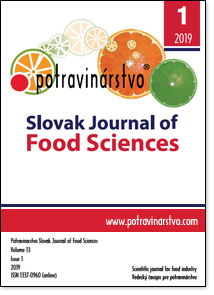Use of ultra-high-temperature processing of raw milk to improve cheese quality
DOI:
https://doi.org/10.5219/1186Keywords:
milk, cheese, UHT processing, cheeseability of milk, cheese ripeningAbstract
The increase in natural cheese production has brought issues related to ensuring the production of high-quality competitive products to the fore. The development of the cheese market requires constant improvement of the existing methods of production and the search for new technological solutions, which will allow us to counterbalance the low quality of raw materials, which is currently a serious problem for domestic cheese production. A promising method of realising the benefits of high-temperature (HT) and ultra-high-temperature (UHT) milk processing in cheese making is the development of new types of cheese with a high moisture content; however, there are very few publications that discuss these approaches. The development of advanced technologies for the production of low-temperature second-degree solid cheeses with the use of HT and UHT processing, related to the improvement of the technological process and the equipment and technological scheme of production of solid cheeses. The main direction of the development of cheese production at the present stage is the improvement of existing technological processes, the development of resource-saving technologies and the improvement of the natural solid rennet cheese quality. The results of our research, related to the study of the composition and safety of milk raw materials, the impact of various technological factors on the cheese production process and the quality of the products obtained, are the basis for our resource-saving technology for the production of solid rennet cheese.
Downloads
Metrics
References
Adámek, M., Adámková, A., Řezníček, M., Kouřimská, L. 2016. The estimated possibilities of process monitoring in milk production by the simple thermodynamic sensors. Potravinarstvo, vol. 10, no. 1, p. 643-648. https://doi.org/10.5219/462 DOI: https://doi.org/10.5219/462
Bashaeva, D. V., Khaerdynov, R. R. 2008. Changes in milk proteins during heat treatment. Dairy Industry, vol. 7, p. 74-75.
Horbatova, K. K. 1984. Biochemistry of milk and dairy products. Moscow, Russia : Light and food industry, 344 p. ISBN 5-901065-48-4.
Hudkov, A. V. 2003. Cheesemaking: technological, biochemical and physico-chemical aspects. Moscow, Russia : DeLy Print, 800 p. ISBN 5-94343-071-7.
Kazumoto, H. U., Tetsuo, S. 1988. Gel-Forming Characteristics of Milk Proteins. 1. Effect of Heat Treatment. J. Dairy Sci., vol. 71, no. 6, p. 1439-1446. https://doi.org/10.3168/jds.S0022-0302(88)79706-4 DOI: https://doi.org/10.3168/jds.S0022-0302(88)79706-4
Khramtsov, A. H., Emelianov, S. A., Evdokymov, Y. A. 2006. The need for bacterial sanitation of raw milk. Dairy Industry, vol. 3, p. 11-16.
Kuznytsov, V. V., Shyler, H. H. 2003. Handbook of a dairy production technologist. Technology and Recipes. St. Peterburg, Russia : GIORD, 512 p. ISBN 5-901065-47-6.
Singh, H., Waungana, A. 2001. Influence of heat treatment of milk on cheesemaking properties. Int. Dairy I., vol. 11, no. 3, p. 543-551. https://doi.org/10.1016/S0958-6946(01)00085-1 DOI: https://doi.org/10.1016/S0958-6946(01)00085-1
Skott, R., Robynson, R. K., Uylby, R. A. 2005. Cheese production: scientific foundations and technologies. St. Peterburg, Russia : Professyia, 464 p. ISBN 5-93913-071-2.
Tepel, A. 1979. Chemistry and physics of milk. Moscow, Russia : Food industry, 623 p. ISBN 978-5-904757-34-2.
Tverdokhleb, H. V., Ramanauskas, R. Y. 2006. Chemistry and Physics of Milk and Dairy Products. Moscow, Russia : DeLy Print, 360 p. ISBN 5-94343-114-4.
Zolotyn, Y. P. 1979. Sterilized milk. Moscow, Russia : Food Industry, 158 p.
Published
How to Cite
Issue
Section
License
This license permits non-commercial re-use, distribution, and reproduction in any medium, provided the original work is properly cited, and is not altered, transformed, or built upon in any way.






























